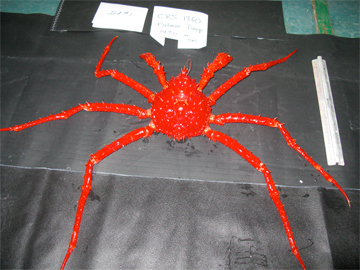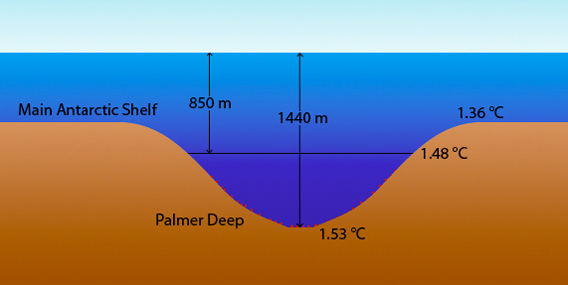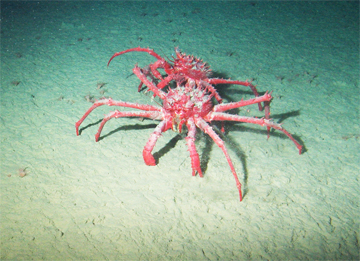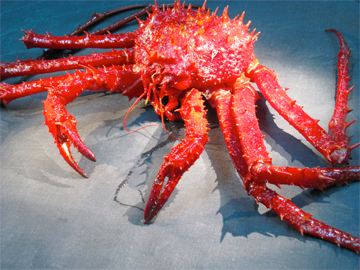Giant crab invasion looms in Antarctica
Dangerous and disruptive king crabs lurk in a deep pocket of the Antarctic continental shelf, clamoring to escape their cold-water prison to reach and permanently change the shallower, prehistoric paradise above.
A team led by University of Hawaii oceanographer Craig Smith spotted the meter-long monsters in February 2010. It was the first time researchers have seen king crabs on the continental shelf—a vast undersea platform that surrounds the Antarctic continent. The crabs are disrupting the environment, feasting on myriads of chilled, undersea animals that had thrived without natural predators for millions of years.
Smith and his team were surprised to find the crabs at depths of 980 meters to 1440 meters in Palmer Deep, a basin within the continental shelf off the Western Peninsula of Antarctica. They reported their observations on September 7 in the Proceedings of the Royal Society B.
 The adult king crabs can grow up to one meter long (ruler: 30 cm) and may weigh 500 grams (1.1 pounds). Photo by: Craig Smith |
“We were actually studying it for other reasons and we did an ROV (remote operated vehicle) survey,” Smith told mongabay.com. “We were interested in the bottom fauna, and that’s when we discovered the crabs—this big population of crabs.”
Smith’s team estimates more than 1.5 million king crabs (Neolithodes yaldwyni) are trapped in Palmer Deep. They’re particularly sensitive to temperature: magnesium that’s ubiquitous in the ocean can act as narcotic in cold seawater and can knock sluggish crabs unconscious and kill them, according to marine biologist Richard Aronson of the Florida Institute of Technology in Melbourne.
The Antarctic shelf waters above Palmer Deep are a fraction of a degree colder, a peculiarity of the parts of the ocean near Antarctica. That seems to be the only thing preventing the spindly crabs from lumbering onto the main shelf 250 meters above their stomping grounds. In the colder conditions above 850 meters in the basin, the crabs and their traces vanish, said Smith.
 Palmer Deep is surrounded by cold water, which kills crabs that wander too far into shallower waters. Currently the crabs are seemingly limited to a depth of 850 meters, but as the Antarctic warms, the crabs’ range will increase. Within a decade or two, they may reach the 400-600 meter depth on the main Antarctic shelf. Note: not to scale. Illustration by: Stephen Tung |
It’s mysterious how the crabs got into the slightly warmer basin in the first place. Seafloor pictures from 1998 show crab tracks in the sediment, suggesting they’ve been there since then. Smith speculates that at one time, warmer, deeper water overflowed and washed crab larvae into Palmer Deep.
After they arrived, the crabs were the first predators on the shelf in millions of years capable of crushing hard-shelled echinoderms, said Aronson in an interview with mongabay.com. He has warned of a potential invasion of king crabs for years.
 King crabs (Neolithodes yaldwyni) have been spotted for the first time on the Antarctic continental shelf. They are disrupting the environment in Palmer Deep. Photo by: Katrien Heirman  Craig Smith’s team collected one pregnant king crab with its ROV. Photo by: Craig Smith |
The marine communities on the underwater shelf above Palmer Deep are unique, Aronson said. “It’s much more reminiscent of the Paleozoic era before all those shell-crushing crabs and bony fish and bottom-feeding sharks and rays evolved,” he said. “The bottom communities in Antarctica are anachronisms. They’re a window to the past. They’re going to get modernized when these crabs show up.”
And they may show up soon. The temperature difference between the crabs’ current lair versus the entrance to the overall shelf is a paltry 0.12 degrees Celsius. Temperatures now increase 0.01-0.02 degrees Celsius at that depth every year, Smith said. So, he fears, it may take just a decade or two for the crabs to ascend to the shelf.
What’s more, Aronson’s team has spotted a comparable population of king crabs (Paralomis birsteini) outside the Antarctic shelf near Marguerite Bay, on the Antarctic slope at a depth of 1,000-1,500 meters, he wrote in a follow-up e-mail interview to mongabay.com. Those crabs may ascend to the shelf as well in a couple of decades.
Two undersea videos show king crabs walking on the seafloor in Palmer Deep on the Antarctic shelf. Videos courtesy of Craig Smith
CITATION: Craig R. Smith, Laura J. Grange, David L. Honig, Lieven Naudts, Bruce Huber, Lionel Guidi, and Eugene Domack. A large population of king crabs in Palmer Deep on the west Antarctic Peninsula shelf and potential invasive impacts. Proceedings of the Royal Society B, 7 September 2011. DOI:10.1098/rspb.2011.1496
Stephen Tung is a graduate student in the Science Communication Program at the University of California, Santa Cruz.
Related articles